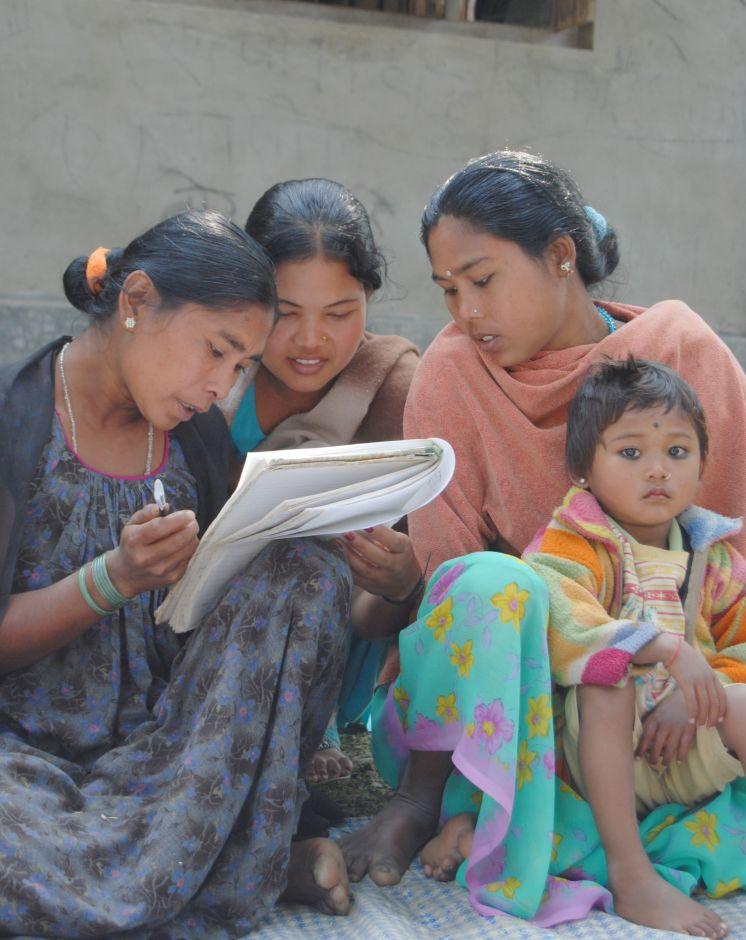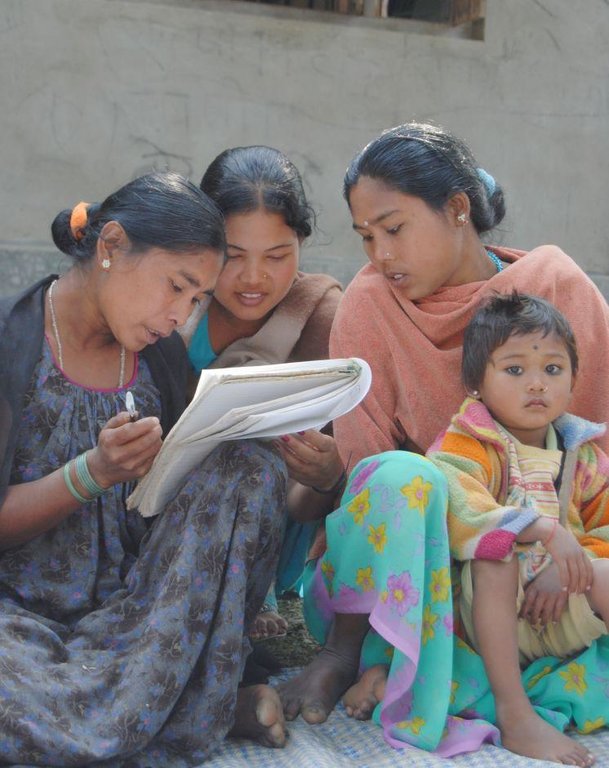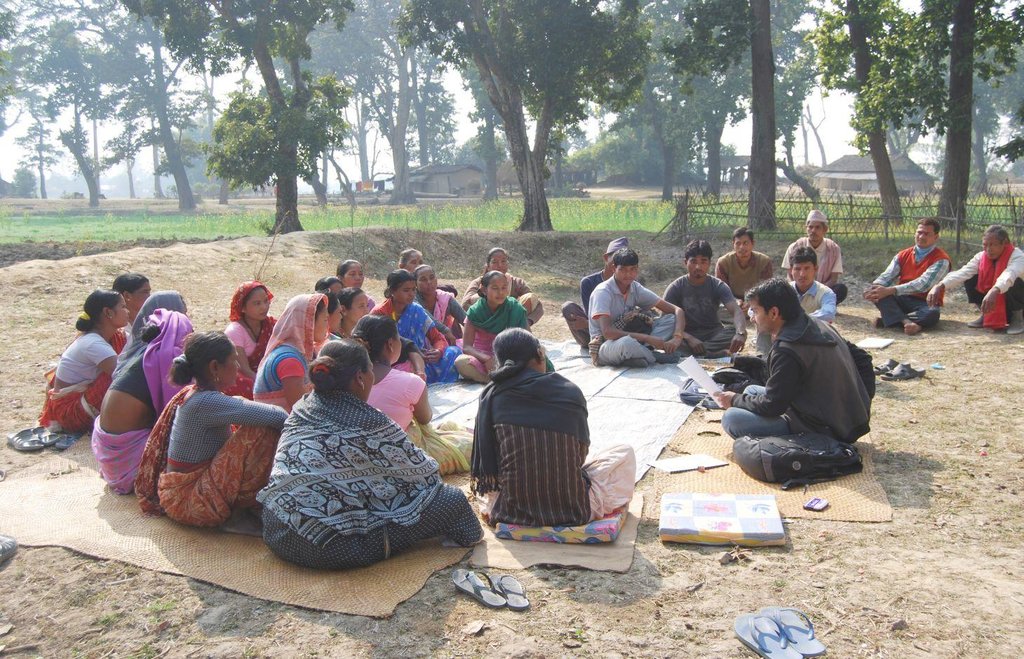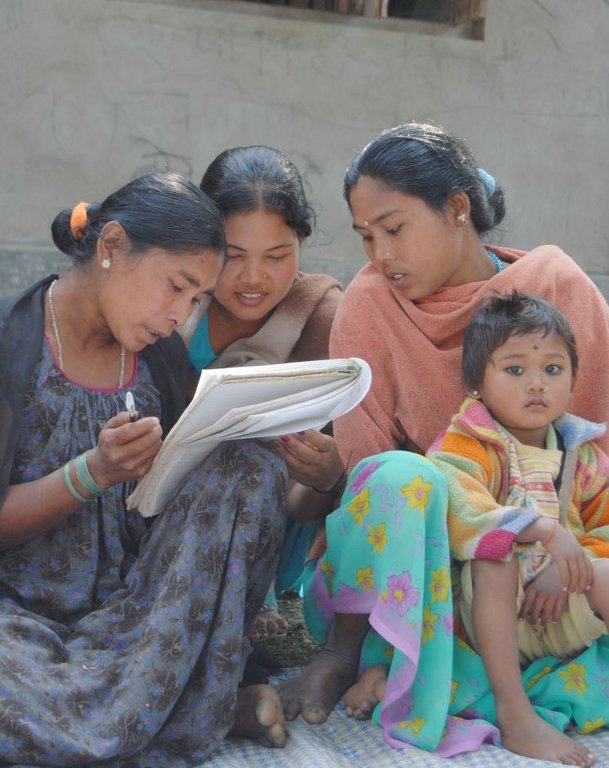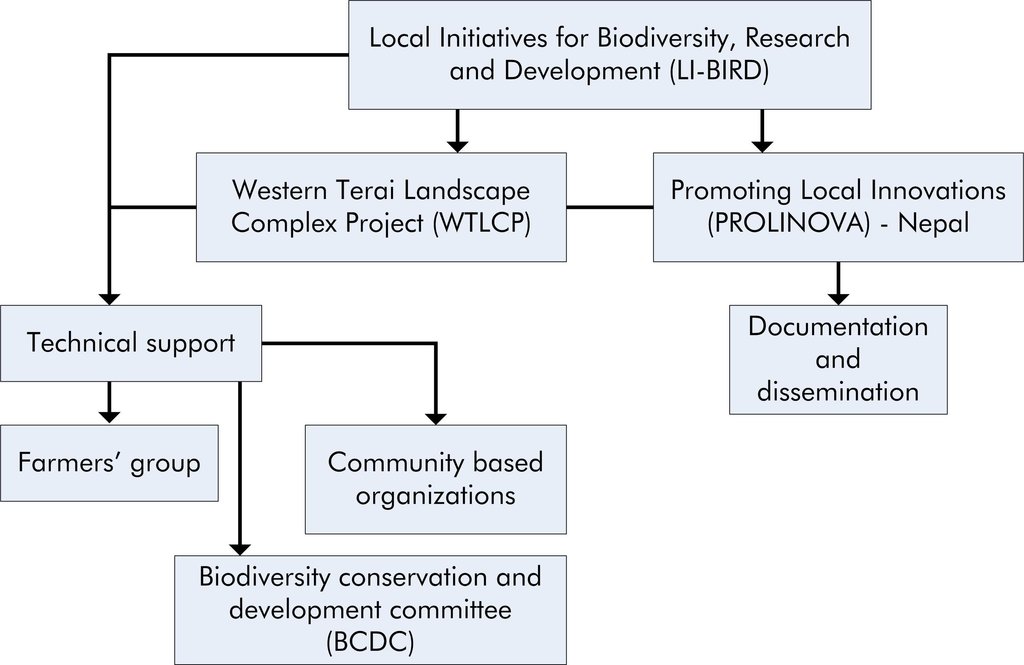Learning about no-till methods through farmer-to-farmer dissemination [Nepal]
- Creación:
- Actualización:
- Compilador: Shreedip Sigdel
- Editor: –
- Revisor: Fabian Ottiger
Kisan - Kisan bichko prasal dwara khanjot nagarikana kheti garne tarika ko addhyan (Main Contributor: Krishna Lamsal, LI-BIRD)
approaches_2531 - Nepal
Visualizar secciones
Expandir todo Colapsar todos1. Información general
1.2 Detalles de contacto de las personas de referencia e instituciones involucradas en la evaluación y la documentación del Enfoque
Especialista MST:
Especialista MST:
Lamsal Krishan
+977 61 5535357/5526834 / 9841483937 (M)
naturekrish@gmail.com / klamsal@libird.org,
Local Initiatives for Biodiversity, Research and Development (LI-BIRD)
P.O.Box 324, Gairapatan, Pokhara
Nepal
Nombre de la(s) institución(es) que facilitaron la documentación/ evaluación del Enfoque si fuera relevante)
ICIMOD International Centre for Integrated Mountain Development (ICIMOD) - NepalNombre de la(s) institución(es) que facilitaron la documentación/ evaluación del Enfoque si fuera relevante)
Kathmandu University (KU) - NepalNombre de la(s) institución(es) que facilitaron la documentación/ evaluación del Enfoque si fuera relevante)
Local Initiatives for Biodiversity, Research, and Development (LI-BIRD) - Nepal1.3 Condiciones referidas al uso de datos documentados mediante WOCAT
¿Cuándo se compilaron los datos (en el campo)?
01/03/2013
El compilador y la/s persona(s) de referencia claves aceptan las condiciones acerca del uso de los datos documentados mediante WOCAT :
Sí
1.4 Referencia/s al/los Cuestionario(s) de Tecnologías MST
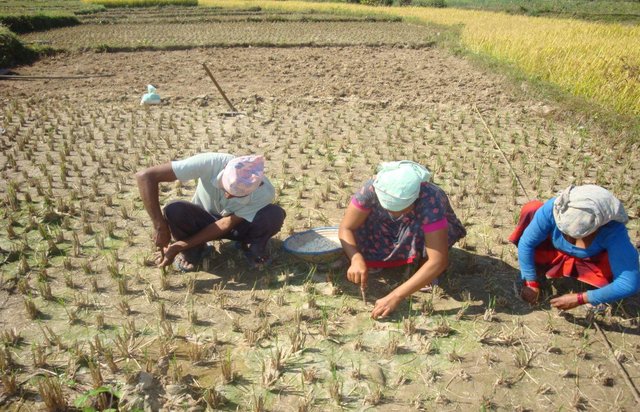
No-till garlic cultivation [Nepal]
No-till is a farming system in which the seeds are planted directly into untilled soil which still contains the previous crop residues. No-till cultivation of garlic is practiced in the tropical lowland districts of western Nepal where garlic is sown directly into the soil after the paddy is harvested.
- Compilador: Shreedip Sigdel
2. Descripción del Enfoque MST
2.1 Breve descripción del Enfoque
Farmer to farmer dissemination of information on no-till methods for garlic cultivation technology
2.2 Descripción detallada del Enfoque MST
Descripción detallada del Enfoque MST:
Aims / objectives: Farmers can learn about alternative or newer methods by sharing their experiences with one another. In this approach, farmers shared information and knowledge on no-till garlic cultivation technology.
Methods: Since no-till methods are not widely known in the area, the approach aimed to increase awareness of the many features of the technique and its benefits. Through farmer-to-farmer dissemination, communities can learn about the various aspects of no-till for crop residue management, resource use, and how it can reduce labour costs. These discussions highlight the environmental and social benefits of no-till methods especially with respect to moisture retention, soil and water conservation, and climate change adaptation.
In 2009, Local Initiatives for Biodiversity, Research, and Development (LI-BIRD), piloted and validated no-till farming in Nepal as a measure for soil and water conservation through the Western Terai Landscape Complex Project (WTLCP) and the Promoting Local Innovation (PROLINNOVA) programme. The dissemination was multi-faceted and the farmers remained engaged throughout the discussions, which included both talks and group participation. Farmers’ groups, community-based organizations, biodiversity conservation groups, and development committees at the village level were given training and technical inputs. This community-level interaction encouraged farmers to discuss with one another as well as to head out to the field for demonstrations and observations. After no-till garlic cultivation was successfully piloted, it was widely adopted by farming communities and especially the indigenous Tharu communities of western Nepal.
2.3 Fotos del Enfoque
2.5 País/ región/ lugares donde el Enfoque fue aplicado
País:
Nepal
Especifique más el lugar :
Gadariya VDC, Kailali District
2.6 Fechas de inicio y conclusión del Enfoque
Indique año del inicio:
10
2.7 Tipo de Enfoque
- iniciativa local reciente/ innovadora
2.8 Propósitos/ objetivos principales del Enfoque
The Approach focused mainly on SLM with other activities (agricultural and livelihood related technology)
• To disseminate information and know-how on no-till methods
• To increase awareness among the farmers on the benefits of no-till methods and crop residue management
• To increase awareness of the environmental and social benefits of no-till methods and the role that it can play in adaptation to climate change
The SLM Approach addressed the following problems: • Lack of awareness about low cost soil and water conservation technologies that address farmers' needs
• Initially there was weak institutional support for organizing discussion sessions
2.9 Condiciones que facilitan o impiden la implementación de la/s Tecnología/s aplicadas bajo el Enfoque
normas y valores sociales/ culturales/ religiosos
- impiden
No-till methods are not widely known in the area
Treatment through the SLM Approach: The group was readily convinced of the economic benefits of no-till methods (especially for garlic production) and this was essential in persuading them to accept the technology.
disponibilidad/ acceso a recursos y servicios financieros
- impiden
Financial resources lacking; this group does not have links to financial institutions.
Treatment through the SLM Approach: Farmers used their own resources
otros
- impiden
Water availability is poor.
Treatment through the SLM Approach: No-till methods help to conserve moisture in the soil.
3. Participación y roles de las partes interesadas involucradas
3.1 Partes interesadas involucradas en el Enfoque y sus roles
- usuarios locales de tierras/ comunidades locales
Community based organization, farmers group
About 60% of those who attend meetings are women. Most of the field activities such as planting and harvesting are performed by women. The indigenous Tharu communities are adopting this technology.
- ONG
LI-BIRD
3.2 Involucramiento de los usuarios locales de tierras/ comunidades locales en las distintas fases del Enfoque
| Involucramiento de los usuarios locales de tierras/ comunidades locales | Especifique quién se involucró y describa las actividades | |
|---|---|---|
| iniciación/ motivación | auto-movilización | Community meetings organized to discuss the new technology and how it could be implemented locally |
| planificación | interactivo | Interactive discussion groups and focal groups organized in the community |
| implementación | auto-movilización | Individual farmers implemented the technology on their land without external support. LI-BIRD provided in-kind and technical information and support. |
| monitoreo y evaluación | auto-movilización | LI-BIRD monitored the implementation of the technology and helped to evaluate the outcome. They collected and analysed data in order to highlight the soil and water conservation aspects of the no-till method and disseminated this information. |
| Research | ninguno |
3.3 Flujograma (si estuviera disponible)
Descripción:
LI-BIRD piloted and validated no-till farming in Nepal as a measure for soil and water conservation through the Western Terai Landscape Complex Project (WTLCP) and the Promoting Local Innovation (PROLINNOVA) programme. Technical support was extended to farmers’ groups, community-based organizations, biodiversity conservation groups, and development committees at the village level.
Autor:
(A. K. Thaku)
3.4 La toma de decisiones en la selección de Tecnología(s) MST
Especifique quién decidió la selección de las Tecnología/ Tecnologías a implementarse:
- principalmente usuarios de tierras con el apoyo de especialistas MST
Explique:
Decisions on the method of implementing the SLM Technology were made by mainly by land users supported by SLM specialists
4. Apoyo técnico, fortalecimiento institucional y gestión del conocimiento
4.1 Construcción de capacidades / capacitación
¿Se proporcionó la capacitación a usuarios de tierras/ otras partes interesadas?
Sí
Especifique quién fue capacitado:
- usuarios de tierras
Si fuese relevante, también especifique género, edad, estatus, etnicidad, etc.
Land users and community mobilizers from the indigenous Tharu communities were given training on no-till method and crop residue management.
Forma de capacitación:
- áreas de demostración
Forma de capacitación:
- Participatory methods and approaches
4.2 Servicio de asesoría
¿Los usuarios de tierras tienen acceso a un servicio de asesoría?
Sí
Especifique si servicio proporcionado se realizó:
- en centros permanentes
Describa/ comentarios:
Name of method used for advisory service: Capacity building training; Key elements: Capacity building took place through site visits and extension materials as well as through discussions and exchanges
4.3 Fortalecimiento institucional (desarrollo institucional)
¿Se establecieron o fortalecieron instituciones mediante el Enfoque?
- sí, moderadamente
Especifique el nivel o los niveles en los que se fortalecieron o establecieron las instituciones:
- local
Especifique el tipo de apoyo:
- construcción de capacidades/ entrenamiento
- Technical support
Proporcione detalles adicionales:
LI-BIRD supported farmers groups, biodiversity conservation and development committees, and community-based organizations by providing hands-on training and technical support.
4.4 Monitoreo y evaluación
¿El monitoreo y la evaluación forman parte del Enfoque?
Sí
Comentarios:
technical aspects were regular monitored by project staff, government, land users through observations; indicators: Regular observations by technical staff from LI-BIRD jointly with representatives from biodiversity conservation and development committees, farmers groups, and community-based organizations
socio-cultural aspects were regular monitored by project staff, land users through observations; indicators: Regular observations by technical staff from LI-BIRD jointly with representatives from biodiversity conservation and development committees, farmers groups, and community-based organizations
economic / production aspects were regular monitored by project staff, government, land users through observations
economic / production aspects were monitored by None through measurement
There were several changes in the Approach as a result of monitoring and evaluation: Several changes were observed. People learned both through discussions and by taking a hands-on approach. An initial attempt to replicate the method ended in failure. However, through discussions and technical inputs, the farmers were eventually able to replicate the method and it is now well understood.
5. Financiamiento y apoyo material externo
5.1 Presupuesto anual para el componente MST del Enfoque
Comentarios (ej. fuentes principales de financiamiento/ donantes principales):
Approach costs were met by the following donors: local community / land user(s) (Mostly by the land users; capacity building activities and field demonstration costs were borne by LI-BIRD.): 100.0%
5.2 Apoyo financiero/material proporcionado a los usuarios de tierras
¿Los usuarios de tierras recibieron financiamiento/ apoyo material para implementar la Tecnología/ Tecnologías? :
No
5.3 Subsidios para insumos específicos (incluyendo mano de obra)
- ninguno
5.4 Crédito
¿Se proporcionó crédito bajo el Enfoque para actividades MST?
No
6. Análisis de impacto y comentarios de conclusión
6.1 Impactos del Enfoque
¿El Enfoque ayudó a los usuarios de tierras a implementar y mantener Tecnologías MST?
- No
- Sí, un poco
- Sí, moderadamente
- Sí, mucho
No-till and better use of crop residues has contributed to improved land management; more moisture is now retained in the soil. Water is in poor supply and vegetable production in this area is limited by the amount of moisture in the soil.
¿El Enfoque empoderó a grupos en desventaja social y económica?
- No
- Sí, un poco
- Sí, moderadamente
- Sí, mucho
The indigenous Tharu communities now have some increased cash income from selling their garlic crop.
Did other land users / projects adopt the Approach?
- No
- Sí, un poco
- Sí, moderadamente
- Sí, mucho
Community-based organizations, as well as members of other communities and neighbouring districts, have either adopted the method or expressed an interest in learning how to implement it.
Did the Approach lead to improved livelihoods / human well-being?
- No
- Sí, un poco
- Sí, moderadamente
- Sí, mucho
Mainly due to increased income from garlic production and reduced labour costs associated with no-till.
Did the Approach help to alleviate poverty?
- No
- Sí, un poco
- Sí, moderadamente
- Sí, mucho
mainly due to increased income from garlic production and reduced labour costs. Studies showed a 25% increase in crop yield and reduced labour requirements.
6.2 Motivación principal del usuario de la tierra para implementar MST
- incremento de la renta(bilidad), proporción mejorada de costo-beneficio
- carga de trabajo reducida
- well-being and livelihoods improvement
6.3 Sostenibilidad de las actividades del Enfoque
¿Pueden los usuarios de tierras sostener lo que se implementó mediante el Enfoque (sin apoyo externo)?
- sí
Si respondió que sí, describa cómo:
This technology has a high probability of being sustainable because it is cost effective and requires minimal technical input (farmers can do it on their own); moreover, it helps with soil conservation.
6.4 Fortalezas/ ventajas del Enfoque
| Fuerzas/ ventajas/ oportunidades desde la perspectiva del compilador o de otra persona de referencia clave |
|---|
| Farmers can easily learn no-till techniques through community participation. The approach is sustainable because it is easy to implement and it appeals to farmers because they appreciate it as a way of reducing labour and increasing crop yields. (How to sustain/ enhance this strength: Continue to give some minor technical support and encouragement.) |
| The approach focused on building capacity by using a hands-on approach similar to how farmers traditionally transfer know-how between themselves. Farmers can adapt and modify the technology as needed to deal with changing conditions in the environment. Financial inputs by external organizations are not needed. (How to sustain/ enhance this strength: Continue to give some minor technical support and encouragement.) |
6.5 Debilidades/ desventajas del Enfoque y formas de sobreponerse a ellos
| Debilidades/ desventajas/ riesgos desde la perspectiva del compilador o de otra persona de referencia clave | ¿Cómo sobreponerse a ellas? |
|---|---|
| Market linkages are poor and the scope to scale up is also small. | The establishment of stronger market linkages would motivate farmers to attempt commercial cultivation. |
7. Referencias y vínculos
7.1 Métodos/ fuentes de información
- visitas de campo, encuestas de campo
- entrevistas con usuarios de tierras
Vínculos y módulos
Expandir todo Colapsar todosVínculos

No-till garlic cultivation [Nepal]
No-till is a farming system in which the seeds are planted directly into untilled soil which still contains the previous crop residues. No-till cultivation of garlic is practiced in the tropical lowland districts of western Nepal where garlic is sown directly into the soil after the paddy is harvested.
- Compilador: Shreedip Sigdel
Módulos
No se hallaron módulos


